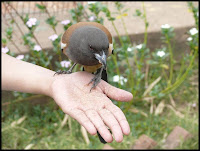Stop looking at your feet
For up in the trees
Swaying in the breeze
Are seeds and flowers, a visual treat.
 Peltophorum pterocarpum - copper pod
Peltophorum pterocarpum - copper pod Wherever I look there are copper pods
Hanging from a Peltophorum that nods
Dropping yellow flowers to form a carpet
A sight that I can never forget.
 Delonix regia - Gulmohar
Delonix regia - GulmoharLook, over there is the Gulmo-har
Without its red flowers does it look below par?
Those brown seed pods, almost two-feet long
Do not induce a song
But did you know, they come from Madagascar?
 Silk Cotton
Silk Cotton
Without its red flowers does it look below par?
Those brown seed pods, almost two-feet long
Do not induce a song
But did you know, they come from Madagascar?
 Silk Cotton
Silk CottonThat silk-cotton tree is completely leaf-less
But oh no, it is definitely not life-less!
See those fat pods just waiting to burst
To every corner seeds dispersed
And into your pillow the cotton may progress!
Mango trees have flowered
And so we may be showered
With fruits so sweet in the month of May
Oh yes, hip hip hurray!
Was there ever a tree so supreme
Like Azadirachta indica, aka Neem?
Its resistant to drought
And carries much clout
Used in so many potions and creams!
 Tabebuia pod
Tabebuia pod
Tabebuia trees in Madras abound
The purple trumpet flowers everywhere are found
But I found the seeds, and they are dehiscent,
Opening to release their contents!
As the temperature rises
I know there are more surprises
So keep your eyes open,
Ladies and gentlemen
As the trees put on more guises.
But oh no, it is definitely not life-less!
See those fat pods just waiting to burst
To every corner seeds dispersed
And into your pillow the cotton may progress!
Mango trees have flowered
And so we may be showered
With fruits so sweet in the month of May
Oh yes, hip hip hurray!
Was there ever a tree so supreme
Like Azadirachta indica, aka Neem?
Its resistant to drought
And carries much clout
Used in so many potions and creams!
 Tabebuia pod
Tabebuia podTabebuia trees in Madras abound
The purple trumpet flowers everywhere are found
But I found the seeds, and they are dehiscent,
Opening to release their contents!
As the temperature rises
I know there are more surprises
So keep your eyes open,
Ladies and gentlemen
As the trees put on more guises.
 Mango flowers
Mango flowers Neem flowers
Neem flowers



 Laggar Falcon
Laggar Falcon Quails
Quails Immature Egyptian vulture?
Immature Egyptian vulture? Cinerous vulture - seen only in semi-arid terrain
Cinerous vulture - seen only in semi-arid terrain White-rumped or white-backed vulture- Gyps bengalensis
White-rumped or white-backed vulture- Gyps bengalensis Eurasian collared dove
Eurasian collared dove Great Indian Bustard
Great Indian Bustard Desert fox
Desert fox Cinkara - male and female
Cinkara - male and female Sand dunes after the dust storm
Sand dunes after the dust storm Feeding treepie
Feeding treepie Mugger-Sariska
Mugger-Sariska Grey Langur relaxing - Sariska
Grey Langur relaxing - Sariska Black-tailed Godwit - Sariska
Black-tailed Godwit - Sariska Sunset - Jaisalmer
Sunset - Jaisalmer

